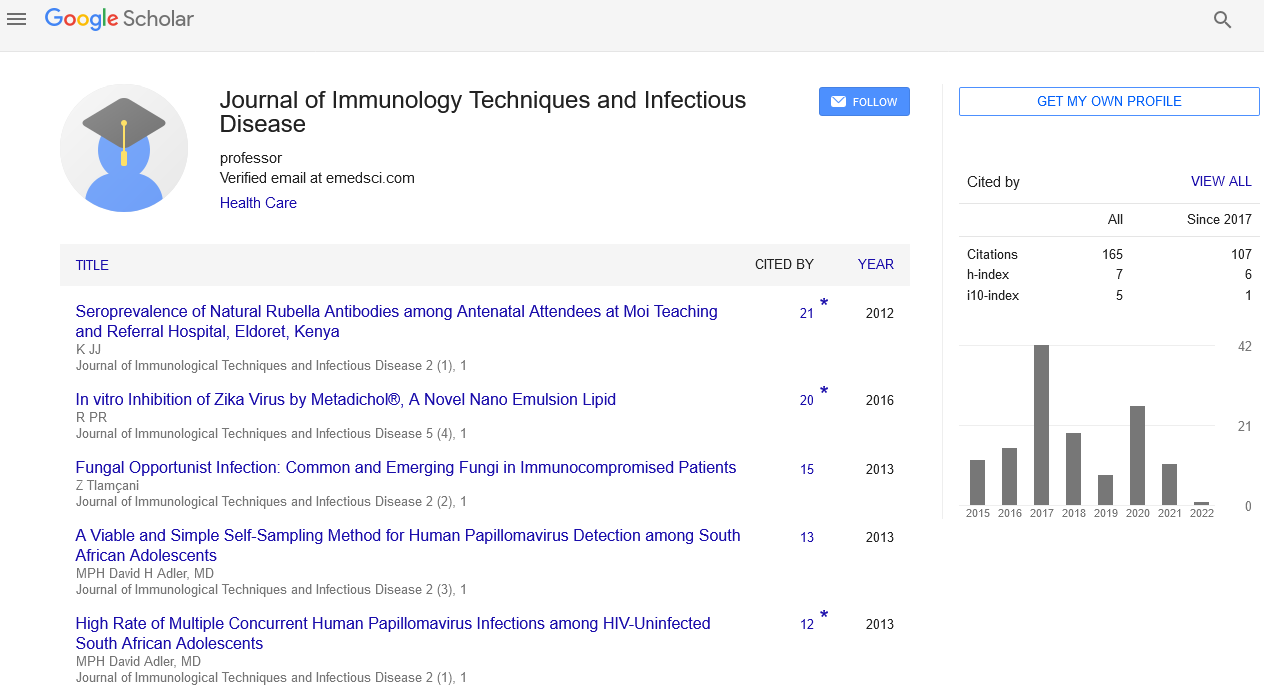Opinion Article, J Immunol Tech Infect Dis Vol: 13 Issue: 3
The Global Challenge of Waterborne Diseases: Health Risks and Prevention
Okafor Kelvin*
1Department of Public Health, Cardiff Metropolitan University, Cardiff, United Kingdom
*Corresponding Author: Okafor Kelvin,
Department of Public Health, Cardiff
Metropolitan University, Cardiff, United Kingdom
E-mail: kelvi.okaf@gmail.com
Received date: 26 August, 2024, Manuscript No. JIDIT-24-151952;
Editor assigned date: 28 August, 2024, PreQC No. JIDIT-24-151952 (PQ);
Reviewed date: 11 September, 2024, QC No. JIDIT-24-151952;
Revised date: 18 September, 2024, Manuscript No. JIDIT-24-151952 (R);
Published date: 25 September, 2024, DOI: 10.4172/2329-9541.1000391
Citation: Kelvin O (2024) The Global Challenge of Waterborne Diseases: Health Risks and Prevention. J Immunol Tech Infect Dis 13:3.
Description
Waterborne diseases are illnesses caused by pathogens, including bacteria, viruses, protozoa and parasites, which are transmitted through contaminated water. These diseases have long been a global public health challenge, especially in areas where access to clean water, sanitation and hygiene is limited. According to the World Health Organization (WHO), millions of people globally are affected by waterborne diseases every year, particularly in low-and middleincome countries where clean drinking water and sanitation infrastructure are inadequate.
Causes of waterborne diseases
Waterborne diseases are primarily caused by drinking or using water that has been contaminated with human or animal feces, which can contain harmful microorganisms. The contamination of water sources typically occurs due to poor sanitation, improper disposal of sewage and runoffs from agricultural activities where animals defecate near water bodies. Inadequate water treatment and improper water storage practices can further spread pathogens.
Common contaminants and causes of waterborne diseases
Bacteria: Many bacteria found in contaminated water can cause severe gastrointestinal infections. Examples include Escherichia coli (E. coli), Salmonella and Vibrio cholerae (which cause cholera).
Viruses: Enteric viruses such as norovirus, rotavirus and hepatitis A are frequently transmitted through contaminated water and can cause illnesses ranging from gastroenteritis to hepatitis.
Protozoa: Protozoan parasites, including Giardia lamblia and Cryptosporidium parvum, can lead to prolonged diarrhea and are particularly difficult to treat.
Helminths: Parasitic worms, such as schistosomes, can infect humans through water contaminated with the larvae. Schistosomiasis, a disease caused by these parasites, affects millions of people, primarily in tropical and subtropical regions.
Types of waterborne diseases
Waterborne diseases contain a broad range of illnesses, most commonly affecting the gastrointestinal system but also provide significant hazards to other body systems. Here are some of the most prevalent waterborne diseases.
Cholera, caused by the bacterium Vibrio cholerae, is characterized by severe watery diarrhea; this can quickly result in dehydration and mortality. Cholera outbreaks are frequent in regions with inadequate sanitation and limited access to protected water for consumption. The disease is commonly transmitted through drinking water contaminated with an infected person's waste products.
Caused by the bacterium Salmonella typhi, typhoid fever is a lifethreatening illness marked by high fever, fatigue, abdominal pain and diarrhea. Typhoid is transmitted by consuming infected foods or beverages. Improved sanitation and vaccination can reduce the prevalence of typhoid fever in at risk populations.
Hepatitis A and E are viral infections that affect the liver and are spread through consumption of contaminated water or food. Symptoms include fatigue, jaundice, abdominal pain and fever. Hepatitis A is preventable through vaccination, but both forms highlight the importance of clean water and sanitation.
Giardiasis is caused by the protozoan Giardia lamblia, which infects the small intestine, leading to symptoms such as diarrhea, gas and stomach cramps. The infection occurs by ingesting water contaminated with the parasite’s cysts, which can survive for long periods in water. Giardiasis is common in areas with poor sanitation and is also prevalent among travelers.
Cryptosporidium parvum, a protozoan parasite, causes cryptosporidiosis, which leads to severe diarrhea, stomach cramps and dehydration. The disease is transmitted through drinking or recreational water contaminated with the parasite. Cryptosporidiosis is particularly dangerous for immunocompromised individuals, who may experience prolonged illness.
Schistosomiasis, typically referred to as bilharzia, is caused by parasitic worms from the genus Schistosoma. This disease is chronic in components of Africa, Asia and South America and it can be transmitted through skin contact with infected water. Symptoms include abdominal pain, bloody urine and in severe cases, organ damage. Schistosomiasis has significant socioeconomic consequences, particularly in agricultural communities.
 Spanish
Spanish  Chinese
Chinese  Russian
Russian  German
German  French
French  Japanese
Japanese  Portuguese
Portuguese  Hindi
Hindi 
